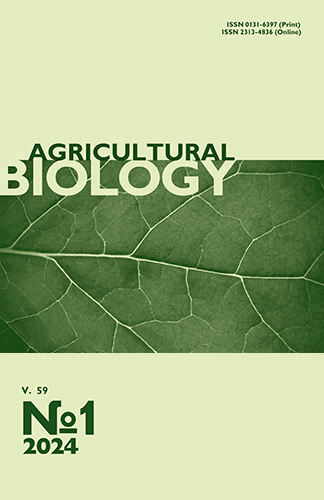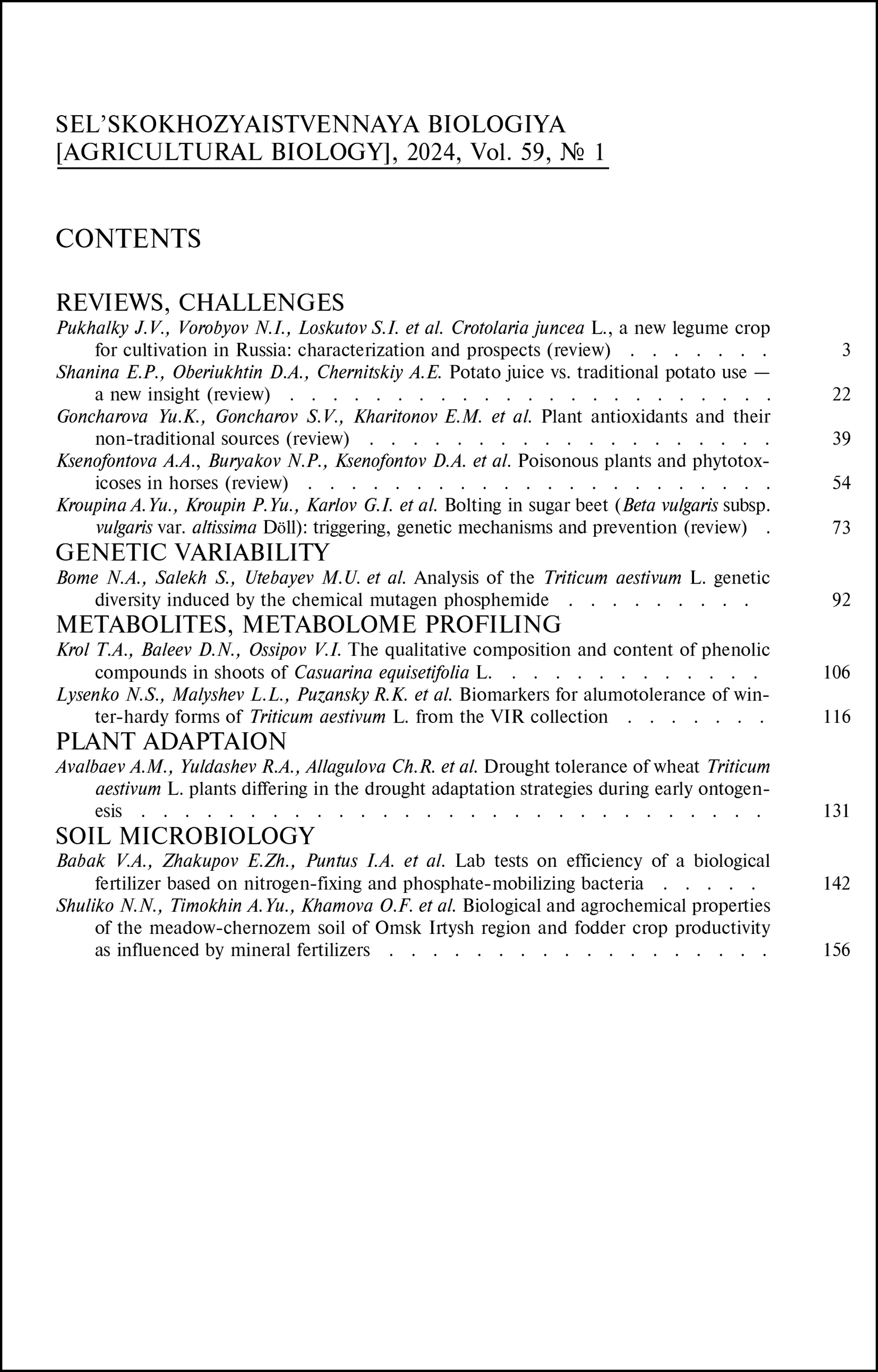doi: 10.15389/agrobiology.2024.1.131eng
UDC: 633.111.1:581.1:632.112
Acknowledgements:
Supported financially by the grant of the Russian Science Foundation (project No. 23-26-00246, https://rscf.ru/project/23-26-00246/)
DROUGHT TOLERANCE OF WHEAT Triticum aestivum L. PLANTS DIFFERING IN THE DROUGHT ADAPTATION STRATEGIES DURING EARLY ONTOGENESIS
A.M. Avalbaev✉, R.A. Yuldashev, Ch.R. Allagulova,
A.A. Plotnikov, O.V. Lastochkina
Institute of Biochemistry and Genetics — Subdivision of the Ufa Federal Research Center RAS, 71, pr. Oktyabrya, Ufa, Russia 450054, e-mail avalbaev@yahoo.com (✉ corresponding author), yuldashevra@gmail.com, allagulova-chulpan@rambler.ru, plotnikow87@mail.ru, oksana.lastochkina@ufaras.ru
ORCID:
Avalbaev A.M. orcid.org/0000-0002-4001-0700
Plotnikov A.A. orcid.org/0009-0006-2968-2262
Yuldashev R.A. orcid.org/0000-0001-9033-6867
Lastochkina O.V. orcid.org/0000-0003-3398-1493
Allagulova Ch.R. orcid.org/0000-0002-7547-8215
Final revision received September 8, 2023
Accepted November 26, 2023
The early stages of ontogenesis during which plants are most sensitive to water deficit, is one of the most crucial in the plant development. Soft wheat (Triticum aestivum L.) is one of the most widespread valuable crops in the world and in the Russian Federation. In the course of natural and artificial selection on the territory of Russia, two ecological groups of wheat were formed, the West Siberian forest-steppe and the Volga steppe ecotypes which differ significantly in the strategy of adaptation to drought. The spring drought is typical for Western Siberia, and, therefore, wheat plants of the forest-steppe West Siberian ecotype grow slowly at the initial stage of ontogenesis. In the southeastern regions of the European Russia, in particular, in the Volga region, drought occurs later, and cultivars of the steppe Volga ecotype, on the contrary, grow intensively at the beginning of the growing season in order to develop an extensive root network by the time of the onset of summer drought. This work has revealed for the first time the role of drought-induced changes in the hormonal balance and in the content of the amino acid proline on the degree of drought tolerance of wheat ecotypes that differ in their adaptation strategy to drought at the initial stage of ontogenesis. The goal of the work was to evaluate various physiological and biochemical parameters of wheat plants of Zauralskaya Zhemchuzhina (forest-steppe West Siberian ecotype) and Ekada 70 (steppe Volga ecotype) cultivars during early ontogenesis under normal and drought conditions. In the first series of experiments, seeds were germinated in Petri dishes (15 seeds per dish) on filter paper moistened with 5 ml of 4 %, 8 % and 12 % sucrose solutions to simulate drought. Petri dishes were placed in a climate chamber and the seeds were germinated in the dark at 22 °C for 3 days. Seeds germinated in distilled water served as a control. On day 3, the energy of seed germination was calculated as the ratio (%) of the number of germinated seeds to the total number of seeds used. The length of the main root of the seedlings was measured. In the second series of tests, pot experiments were carried out under controlled conditions. Seeds were sown in 15 liter pots (30 plants per pot, sowing depth was 4-5 cm, distance between rows was 2.5 cm, and distance between plants in a row was 2.5 cm). In the control pots, the soil moisture was maintained at 70 % of the total water retention capacity of soil. Other plants were subjected to early soil drought by not watering until the soil moisture dropped to 30 % of the total water retention capacity of soil. On days 7, 8 and 9, the fresh and dry weight of control and drought-stressed seedlings were measured. The contents of cytokinins (CK), indoleacetic acid (IAA) and abscisic acid (ABA) in 10 seedlings with fresh weight of 0.9-1.0 g on day 7, 8 and 9 were determined by the enzyme-linked immunosorbent assay (ELISA) using hormone specific rabbit antibodies and peroxidase-labeled anti-rabbit antibodies. Extraction of free proline and its quantification were also carried out. It was revealed that concentrated solutions of sucrose simulating drought reduced the energy of seed germination and inhibited the main root growth of 3-day-old seedlings of both wheat ecotypes. It should be noted that the inhibition of both seed germination and main root growth was more pronounced in the Zauralskaya Zhemchuzhina cultivar. Soil drought also suppressed the growth of 7-9-day-old seedlings, and the suppression was also more pronounced in the Zauralskaya Zhemchuzhina plants. We revealed an imbalance in phytohormone levels in 7-9-day-old seedlings of both cultivars associated with the drought-induced accumulation of ABA and a decrease in the contents of CK and especially auxins. However, in Ekada 70 seedlings the range of drought-induced changes in hormonal balance was noticeably smaller compared to Zauralskaya Zhemchuzhina plants. It was also found that the soil drought led to an increase in the content of proline, an important osmoprotectant, while a higher concentration of proline was characteristic of 7-9-day-old seedlings of Ekada 70 cultivar both under normal and stress conditions. To summarize, our findings indicate a higher drought tolerance during early ontogenesis of the steppe Volga ecotype plants compared to the forest-steppe West Siberian ecotype plants. This is probably due to less altered phytohormone profiles and the increased osmoprotectant proline accumulation in the steppe Volga ecotype plants under drought.
Keywords: Triticum aestivum, wheat, ecotypes, drought, hormonal system, proline.
REFERENCES
- Razi K., Muneer S. Drought stress-induced physiological mechanisms, signaling pathways and molecular response of chloroplasts in common vegetable crops. Critical Reviews in Biotechnology, 2021, 41(5): 669-691 CrossRef
- Allagulova C.R., Lubyanova A.R., Avalbaev A.M. Multiple ways of nitric oxide production in plants and its functional activity under abiotic stress conditions. International Journal of Molecular Sciences, 2023, 24(14): 11637 CrossRef
- Riedesel L., Möller M., Horney P., Golla B., Piepho H.P., Kautz T., Feike T. Timing and intensity of heat and drought stress determine wheat yield losses in Germany. PLoS One, 2023, 18(7): e0288202 CrossRef
- Stallmann J., Schweiger R., Müller C. Effects of continuous versus pulsed drought stress on physiology and growth of wheat. Plant Biology, 2018, 20(6): 1005-1013 CrossRef
- Dietz K.J., Zörb C., Geilfus C.M. Drought and crop yield. Plant Biology, 2021, 23(6): 881-893 CrossRef
- Fang Y., Xiong L. General mechanisms of drought response and their application in drought resistance improvement in plants. Cellular and Molecular Life Sciences, 2015, 72(4): 673-689 CrossRef
- González E.M. Drought stress tolerance in plants. International Journal of Molecular Sciences, 2023, 24(7): 6562 CrossRef
- Pshenitsa v SSSR /Pod redaktsiey P.M. Zhukovskogo [Wheat in the USSR. P.M. Zhukovskiy (ed.)]. Moscow, 1957 (in Russ.).
- Tsygankov V.I. Izvestiya Orenburgskogo gosudarstvennogo agrarnogo universiteta, 2011, 2(30): 46-50 (in Russ.).
- Mukhitov L.A., Samuilov F.D. Vestnik Kazanskogo gosudarstvennogo agrarnogo universiteta, 2014, 9(3): 135-138 (in Russ.).
- Likhovidova V.A., Kazakova A.S., Samofalova N.E. Zernovoe khozyaystvo Rossii, 2019, 5(65): 34-39 CrossRef (in Russ.).
- Sharafutdinov M.Kh., Reshetnyak V.V., Validov Sh.Z., Safin R.I. Vestnik Kazanskogo GAU, 2017, 2(44): 64-70 CrossRef (in Russ.).
- Lastochkina O., Yakupova A., Avtushenko I., Lastochkin A., Yuldashev R. Effect of seed priming with endophytic Bacillus subtilis on some physio-biochemical parameters of two wheat varieties exposed to drought after selective herbicide application. Plants, 2023, 12: 1724 CrossRef
- Batygina T.B. Khlebnoe zerno: atlas [Bread grain: atlas]. Leningrad, 1987 (in Russ.).
- Shakirova F.M., Sakhabutdinova A.R., Bezrukova M.V., Fatkhutdinova R.A., Fatkhutdinova D.R. Changes in the hormonal status of wheat seedlings induced by salicylic acid and salinity. Plant Science, 2003, 164(3): 317-322 CrossRef
- Bates L.S., Waldran R.P., Teare I.D. Rapid determination of free proline for water stress studies. Plant and Soil, 1973, 39: 205-207 CrossRef
- Peleg Z., Reguera M., Tumimbang E., Walia H., Blumwald E. Cytokinin-mediated source/sink modifications improve drought tolerance and increase grain yield in rice under water-stress. Plant Biotechnology Journal, 2011, 9(7): 747-758 CrossRef
- Hura T., Hura K., Ostrowska A. Drought-stress induced physiological and molecular changes in plants. International Journal of Molecular Sciences, 2022, 23(9): 4698 CrossRef
- Liu X., Quan W., Bartels D. Stress memory responses and seed priming correlate with drought tolerance in plants: an overview. Planta, 2022, 255(2): 45 CrossRef
- Guo Q., Wang Y., Zhang H., Qu G., Wang T., Sun Q., Liang D. Alleviation of adverse effects of drought stress on wheat seed germination using atmospheric dielectric barrier discharge plasma treatment. Scientific Reports, 2017, 7(1): 16680 CrossRef
- Kong H., Meng X., Akram N.A., Zhu F., Hu J., Zhang Z. Seed priming with fullerol improves seed germination, seedling growth and antioxidant enzyme system of two winter wheat cultivars under drought stress. Plants, 2023, 12(6): 1417 CrossRef
- Mukhitov L.A., Samuilov F.D. Vestnik Kazanskogo gosudarstvennogo agrarnogo universiteta, 2007, 2(1): 57-59 (in Russ.).
- Shakirova F., Allagulova Ch., Maslennikova D., Fedorova K., Yuldashev R., Lubyanova A., Bezrukova M., Avalbaev A. Involvement of dehydrins in 24-epibrassinolide-induced protection of wheat plants against drought stress. Plant Physiology and Biochemistry, 2016, 108: 539-548 CrossRef
- Andrade A., Boero A., Escalante M., Llanes A., Arbona V., Gómez-Cádenas A., Alemano S. Comparative hormonal and metabolic profile analysis based on mass spectrometry provides information on the regulation of water-deficit stress response of sunflower (Helianthus annuus L.) inbred lines with different water-deficit stress sensitivity. Plant Physiology and Biochemistry, 2021, 168: 432-446 CrossRef
- Waadt R., Seller C.A., Hsu P.-K., Takahashi Y., Munemasa S., Schroeder J.I. Plant hormone regulation of abiotic stress responses. Nature Reviews Molecular Cell Biology, 2022, 23: 680-694 CrossRef
- Llanes A., Andrade A., Alemano S., Luna V. Alterations of endogenous hormonal levels in plants under drought and salinity. American Journal of Plant Sciences, 2016, 7(9): 1357-1371 CrossRef
- Ozturk M., Turkyilmaz Unal B., García-Caparrós P., Khursheed A., Gul A., Hasanuzzaman M. Osmoregulation and its actions during the drought stress in plants. Physiologia Plantarum, 2021, 172(2): 1321-1335 CrossRef
- Du L., Huang X., Ding L., Wang Z., Tang D., Chen B., Ao L., Liu Y., Kang Z., Mao H. TaERF87 and TaAKS1 synergistically regulate TaP5CS1/TaP5CR1-mediated proline biosynthesis to enhance drought tolerance in wheat. New Phytologyst, 2023, 237(1): 232-250 CrossRef
- Bhagyawant S.S., Narvekar D.T., Gupta N., Bhadkaria A., Koul K.K., Srivastava N. Variations in the antioxidant and free radical scavenging under induced heavy metal stress expressed as proline content in chickpea. Physiology and Molecular Biology of Plants, 2019, 25: 683-696 CrossRef
- Avalbaev A., Allagulova Ch., Maslennikova D., Fedorova K., Shakirova F. Methyl jasmonate and cytokinin mitigate the salinity-induced oxidative injury in wheat seedlings. Journal of Plant Growth Regulation, 2021, 40: 1741-1752 CrossRef
- Wani A.S., Ahmad A., Hayat S., Tahir I. Epibrassinolide and proline alleviate the photosynthetic and yield inhibition under salt stress by acting on antioxidant system in mustard. Plant Physiology and Biochemistry, 2019, 135: 385-394 CrossRef












